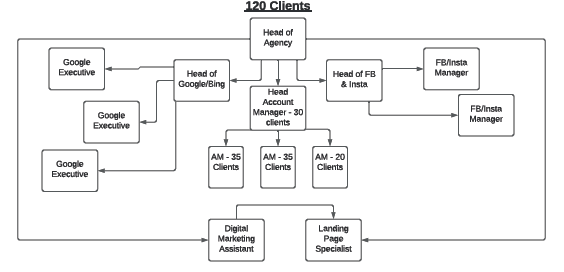 One of the questions I get asked the most from clients is about recruitment….
One of the questions I get asked the most from clients is about recruitment….
- How do we do it?
- How long does it take?
- What is the accountability and training like once they start?
- How do you create a scorecard?
In our company, and in others you might admire, you see the great and the good – the team that took years to build. The team that kicks ass together and puts people first.
What you don’t see is how long it took us to get there. How many interviews we’ve done, how many changes we’ve made to job titles, how many scorecards we’ve created, how many onboardings that we’ve started but never got to complete. You get to see what stuck….
Everyone wants the magic recruitment button – but it doesn’t exist. It takes time, understanding, more time, candidates, the right description, time.. oh, did I mention time?
When recruiting, I start looking at where the holes are in our processes.
Am I asking another department for help more than usual? If I am going to a certain member of the team for consistent help to create marketing materials or blogs, maybe I need more of a writer role? Is there a weakness I need to fill? Where is the team falling behind?
Are you planning to move to a bigger physical therapy clinic, or open a new clinic? If so, is your current staff enough to handle the increased demand?
How long do I have before we come reactive instead of proactive? What can we handle?
Am I looking for someone who is a doer or a thinker?
This is BIG. Do you want the next hire to be someone who implements your plan, or do you want someone who takes the initiative.
As a new and growing company, we want to hire what we need, and not more than what we need.
We want to make the right recruitment decisions and hires and this does not happen overnight.
The Private Practice Marketer solid team of 7 did not happen easily. As we grow and need more, I need to be able to identify where we struggle as a team, and where we excel. Is it OK to move job roles around? Let’s build on the skills they have, and use our resources to our advantage.
I am sure we have all heard the endless recruitment horror stories. The people who just didn’t work out, and whether it was you or them that made the final decision, GOOD ON YOU. It wasn’t meant to be. I have been looking and recruiting for a new member of the team for months. I haven’t found that right person yet, but I know they are out there. I am not willing to hire and put the effort of training into someone that I think “might” work. I want to be certain, while still understanding that they might not work out.
Who I am hiring for has changed significantly over the past few months.
It worries me to hire someone who is client facing and they don’t work out. Our clients are the #1 priority in this business and I don’t want to introduce them to someone who might not be here in the coming months. We take client relationships VERY seriously, which is why it is important to us that we have the perfect fit.
I have a notes section on my desktop, that I often edit, of skills and characteristics I am looking for in team members.
Know what is important to you, and what you can teach. Know what you can’t teach.
I cannot (and do not want to) teach time management, confidence, and organizational skills. No matter what position I am looking to fill, I have the avatar in my head. Now I just have to find the right person.
Create a Scorecard for Your New Hires
Completing the scorecard BEFORE you hire, is crucial!
Know your expectations for the role, make sure the candidates know the expectations of the role. If you don’t know what you are hiring for, they don’t know what they are doing, no matter how skilled.
When creating a scorecard you need the following points:
Purpose of the role: Why do you want this role? What is their purpose of joining the company?
Big 3-5 Strategic Outcomes: Just like it says, think BIG. Overall picture big. Strategic.
Results and Outcomes Required for Success: What does success look like in order to achieve the Big 3-5.
Tasks & Responsibilities: Here is where you outline what you want them to take over in certain time periods. This can change, and that’s OK. Ask yourself if these tasks are contributing to the results and outcomes that are required for success on a daily, weekly, monthly AND ongoing basis.
It is very important that you know the difference between your big 3-5 strategic outcomes and your results and outcomes required for success. Go over the scorecard with them before day 1.
It is very important to me that we hire before we need to. I need time to train the new starter, I need time to introduce them to our culture and company values, I need time to make sure they are a good fit and what we need.
Here is what has helped me when looking for hires: Our 12 month Org Chart.

The purpose of this chart is to keep us on track for our goals that we set in annual planning. That doesn’t mean it hasn’t changed, it has, a lot.
But now after Q1 that we have a solid product to offer our clients, and know how we want to move forward, I have a better idea of who and when I need to hire.
This will probably change again and again, but it always adjusts based on our annual planning goals and the main goals we are striving for as a company.
I want to make sure I have the resources I need to hit those goals, and staff are the heart of that. This is how I stay ahead of the curve, how we continue to be proactive instead of reactive, how we can see the influx of clients coming after an event and how we know the number of clients we can take on each month before hitting our limit.
This also helps us to make sure our pricing is right. Can we sustain everything we offer at our current price point? Are we hitting our revenue goals? How can we make what we offer better than someone else?
We do this by planning. We plan for the clients. We plan so that when we tell you there’s a wait list, or there’s only a few spots left, it’s absolutely true. We know what we can take on and can handle. I learned that from partnering with a third party who did not know that, and it showed.
So well done: You’ve hired. Now what?
Plan out what you want them to do over the next week or 2. Lay out what their tasks are and what they need to do to get to know the company. You can’t expect someone to know what to do on the first day, week, or even month, if you haven’t made it clear.
Does the role that you’ve hired for come with training? Some of ours do, and some don’t. There are things as a team we can, and do, teach. Others, we don’t. It’s really important to know what those factors are. If you have never done marketing before, you don’t want to also hire a marketing assistant who has never done marketing before, because you can’t train them.
Be honest and set expectations immediately. Ideally you will share the scorecard with your new hire before day 1. We’ve had people leave instantly after simply seeing the scorecard: GOOD. We don’t want someone to start if they are scared of accountability. We want someone to embrace the responsibility and challenges ahead. If someone declines the role after seeing a scorecard, it means you did an excellent job of setting expectations and they weren’t up for it. Well done you.
Scorecard conversations are key.
Start them right away and do them consistently. I schedule my one-to-one scorecard conversations every other week at the same time with each team member. I keep it this way so we can dig into their role, what’s happening, and make sure they are staying in line with their actual scorecard. Everyone is required to have this done 24 hours before our meeting. Scorecard conversations keep us both accountable, and let me find the holes and weaknesses we have, and if I need to hire, reassess the scorecard, and identify potential problems.
Earlier this year our leadership team read Scaling Up (by Verne Harnish). It was a great book, and one of my key takeaways was if someone is never stuck, or asking for help it’s either because they don’t want to ask you, or they don’t care enough to find where they are stuck.
Pay attention to what your team is AND is not asking for, new and established staff alike. It will keep you on the right track.
Discover How to Confidently, Ethically and Professionally Sell Your Physical Therapy Services
 Check out Paul’s Best Selling book To Sell is Healthy.
Check out Paul’s Best Selling book To Sell is Healthy.
Discover how to get unshakable confidence to sell your physical therapy services - at twice the price you are now.
This is a MUST READ for any Private Practice Owner who feels worried or guilty about what their patients will think about raising prices in your clinic.
Instead of worrying over being judged by patients or peers, or living in fear of rejection to what you’re selling, discover the principles behind Paul Gough’s new Effortless Selling System that’ll turn you into a magnet for certainty and confidence attracting more patients than you can handle.
